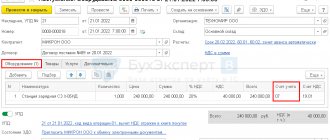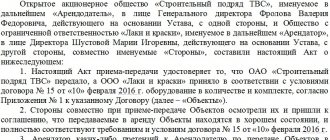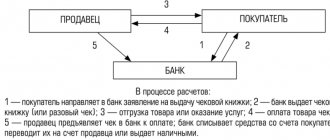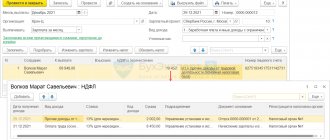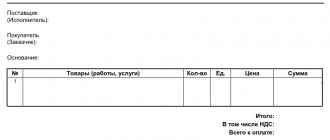Companies that use different types of equipment generally work according to the same scheme. First, the equipment arrives at the warehouse, then it is transferred for subsequent installation, assembly and debugging, then there is a test period, after which it is registered as a fixed asset. When the equipment is received at the warehouse, an act is drawn up in the OS-14 form. If there is a need for assembly, a certificate of acceptance and transfer of equipment for installation is drawn up in form OS-15. We discuss how to fill out this act in this article.
Below there is a link to download the current OS-15 form and an example of how to fill it out.
Depending on the complexity of the installation, it can be performed by both employees of the organization and representatives of companies specializing in this type of service. If other companies are involved in installation, a separate version of the act is drawn up for them.
When is OS-15 used?
The form is completed for assets that require assembly, installation and commissioning before being placed into service.
An act of acceptance and transfer of equipment for installation, form OS-15, is drawn up if the restoration into working condition is carried out by a company that is not related to the equipment.
Installation of fixed assets can be carried out in-house or with the help of third-party specialized companies. In the second case, an additional copy of the act is required for the installation company.
For objects for which installation is not required, it is not necessary to fill out the OS-15 form. Such equipment is immediately accepted as a fixed asset in the form OS-1, OS-1a or OS-1b.
In the future, the installed facility will be put into operation as a fixed asset.
general information
Any company has some assets, and it is important not only to reliably protect them, but also to operate them effectively. To do this, they should be clearly controlled, transferred for temporary possession to other legal entities (without changing ownership), if this is economically beneficial, and this fact should be reflected in the accompanying documentation of the enterprise.
Please note that the legislation does not require the use of any one standard form. Any organization has the right to develop its own, convenient for employees and, in principle, simple sample of an acceptance certificate for goods and materials (inventory assets) - the main thing is that the form contains all the required details, a full list of which we will provide below. If you don’t have time for this, you can do it even more logically and fill out the MX-1 form, because it has several advantages:
- traditional for document management practice and therefore familiar to representatives of various authorities;
- unified and therefore understandable;
- convenient for adjustments - it’s no problem to add the necessary data to it or delete unnecessary ones.
In practice, this is what most companies prefer, so it can be considered a standard. Just remember that it must be certified in any case so that it complies with the accounting policies of the enterprise.
Procedure for filling out the standard form
The basis for drawing up an act of acceptance and transfer of an object for installation in the OS-15 form, as a rule, is a contract agreement.
The unified form OS-15 is filled out on both sides.
The front side contains information about the parties involved, as well as the equipment itself; the back side contains inspection data, conclusion and signatures of the parties.
Front - contains information about the name of the customer enterprise with the designation of the OKPO code, the department that accepted the equipment for subsequent installation (garage, warehouse, site).
Next, the basis for drawing up the acceptance certificate is recorded - the contract, its number and the date of signing.
After the title of the document, fill in the number of the form and the day of its preparation, on the left - the dates of delivery of the equipment for installation, under the contract and actual.
When filling out the title page of the OS-15 form, you should pay attention to the fields indicating the dates of commissioning for installation and operation:
- The day of commissioning of the assembled equipment is taken from the contract or other document - this will be the planned day.
- The actual day of transfer of working property into operation is indicated below, filled in upon acceptance of the finished object for accounting.
The place where the transfer and acceptance certificate is drawn up is indicated in full below:
- name of company;
- locality;
- Street;
- structural subdivision.
Next, the names of the enterprises of the equipment manufacturer, supplier and installation company are written down in order.
OKPO codes are indicated next to each name. Then the department that accepted the equipment for installation is registered in the OS-15 form.
All information about the set of equipment for subsequent assembly is entered into the table:
- Name of equipment;
- serial number;
- element marking;
- serial position according to the assembly diagram;
- day of arrival at the warehouse;
- number of the act of acceptance of objects, their quantity and cost (total and for an individual unit of the element).
Additional information is recorded in the last column.
On the reverse side of the acceptance certificate form, the compliance of the equipment with the presented drawings and design specialization (whether it is complete) is noted, a detailed list of all elements of the equipment is listed, indicating their quantity.
If defects are identified during the installation of equipment, a report is drawn up (form OS-16).
The final conclusion on acceptance of equipment for installation may contain the phrase “the equipment is suitable for use, no defects were identified.”
The document must contain signatures from representatives of both companies, who are responsible for maintaining the integrity of the equipment set during its assembly.
The fixed asset item is transferred to the employee responsible for ensuring the safety of the equipment.
Upon completion of installation, the equipment is accepted for accounting as a fixed asset on the basis of the drawn up act OS-1 (OS-1a).
Certification of the act of acceptance and transfer for installation with stamps is not a mandatory condition; today, legal entities have the right not to use stamped products if their need is not indicated in the local documentation of the enterprise.
The act, completed in form OS-15, is an annex to the contract for the supply of equipment, which confirms the provision of a set of objects from one company to another, their introduction or withdrawal from the production capabilities of the enterprise.
Equipment is accepted into the enterprise warehouse according to an OS-14 act, after which it is accepted and transferred for installation with the OS-15 act drawn up.
Filling out the OS-15 form is fully regulated by the legislation of the Russian Federation; its use is necessary to control the costs of various companies.
Drawing up a transfer and acceptance certificate is required for enterprises involved in the transfer of used equipment from the delivery company, as well as when purchasing a new technical object through a distribution network, an individual entrepreneur, or production with their own capabilities.
Below is a free download of the unified form and a completed example of the OS-15 form.
acceptance certificate for installation OS-15 - excel.
filling out form OS-15 - excel.
What the completed form looks like:
Compilation in free simple form
A specially designed form OS-15 contains all the necessary information about the property transferred for subsequent installation. It is not legally prohibited to develop your own form for the acceptance certificate for installation.
It should contain information:
- information about the delivery company and the recipient, if the object is new, then the delivery person is not recorded;
- the contract that serves as the basis for the purchase procedure;
- date of acceptance of equipment for registration;
- manufacturing organization, depreciation group of the object.
Sometimes a special commission is formed to carry out installation activities. One of the commission members must be a specialist from the performing company. In this case, an additional copy of the act is not required. If necessary, you can make a photocopy of the form.
When receiving equipment for storage, the authorized representative signs the document and then receives a copy of it.
In other cases, the document is drawn up at the time of transfer of equipment in 2 copies. One of them remains for the recipient, the other for the transmitting party.
It is allowed to fill out the act either by hand (only with a ballpoint pen, but not with a pencil) or using a computer.
The document is drawn up in 2 copies: one is sent to the accounting department employee, where it acts as a confirming document for the transfer of equipment from the customer to the installation organization, and also serves as the basis for registering the property as a fixed asset, the second is sent to the installation contractor.
Example
Below is a sample of how you can draw up an act of acceptance and transfer of equipment to an installation company in a free, simple form.
act in a simple form - word.
What a simple form looks like:
Who is involved in the preparation of documentation?
In cases where, as part of cooperation between two business entities that have entered into an agreement, it is planned to transfer any material assets - on the basis of a sale agreement, lease, or other transaction - the transfer document is drawn up with the participation of both parties. In addition to the transferring and receiving entity, in some cases the presence of an engaged specialized expert may also be required to confirm the quality and functional characteristics of the subject of the transaction.
To find the correct source and formalize everything properly, it is usually enough - for example, an act of acceptance and transfer of equipment or machinery (for repair, for installation or operation after acceptance), signed by authorized representatives, certifies not only the fact of movement of inventory valuables, but also their good condition at the time of receipt. The presence of a document is also the basis for accounting operations when one of the counterparties writes off property from the balance sheet, and the second classifies it as fixed assets or another category of assets.
Design features
When completing the procedure for acceptance and transfer of equipment items for installation, it is necessary to comply with certain points:
- mandatory participation of each party having the right to sign;
- when executing a transaction on the territory of the transferring party, the receiving organization provides a power of attorney to the authorized person;
- when the process takes place on the territory of the receiving party, an act of acceptance of components for installation is drawn up by it (simultaneously with the equipment); recipients are given accompanying documentation;
- Recipients of equipment can involve third-party experts to study it in more detail.
When accepting equipment, you should very carefully check that the serial numbers on the fixed assets themselves and on the invoices match.
What is he like?
The simplest act of acceptance and transfer of goods and materials (inventory), the form of which we will separately provide below, is precisely the primary accounting documentation. Therefore, it must contain a detailed description and key distinctive characteristics of those things that become the objects of the transaction:
- purchase and sale;
- deliveries, one-time or regular;
- registration of a lease agreement (relevant not only for real estate);
- responsible storage.
The property described by this paper includes goods, raw materials for the manufacture of products, auxiliary materials such as additives or dyes, spare parts, semi-finished products, containers, and fuel. The main thing is that the work of the enterprise is simplified.
